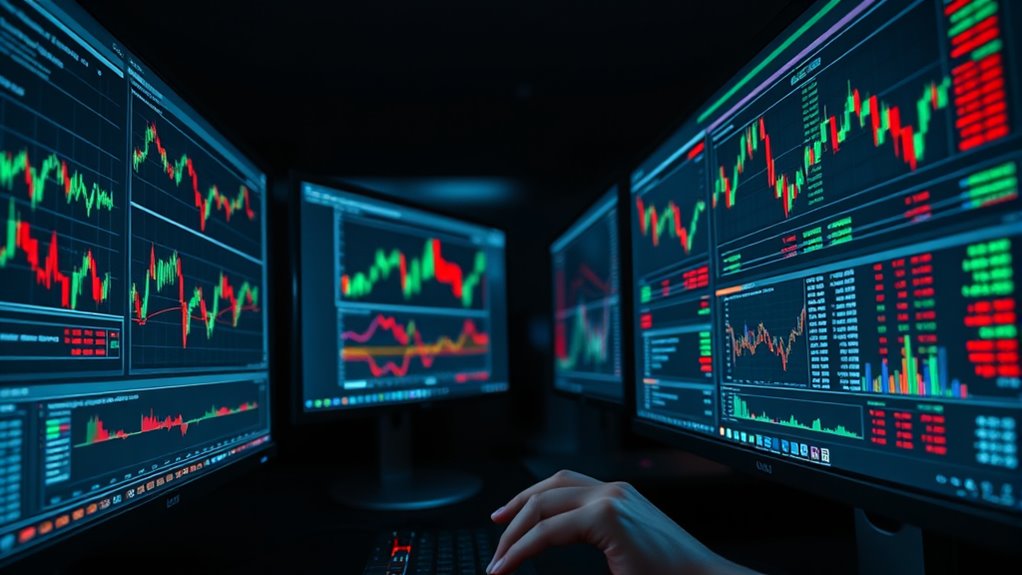AI helps you detect insider trading by analyzing vast amounts of trading data in real time. It identifies suspicious patterns, unusual trade volumes, and irregular behaviors faster than manual methods. Techniques like sentiment analysis and natural language processing uncover hidden inside information shared through communication channels. These systems also adapt to evolving rules and improve accuracy over time. If you’re curious about how AI enhances market oversight, there’s plenty more to explore below.
Key Takeaways
- AI analyzes large trading datasets in real time to identify suspicious patterns indicative of insider trading.
- Machine learning models like Random Forest and XGBoost improve detection accuracy and reduce false positives.
- Sentiment analysis of news, social media, and communications uncovers hidden signals of illicit activity.
- Continuous monitoring flags unusual trades and rapid trading patterns for investigative focus.
- Integration of diverse data sources enhances the reliability and comprehensiveness of insider trading detection.

Artificial intelligence is transforming how regulators and firms detect insider trading by analyzing vast amounts of trading data in real time. This technological shift allows you to identify suspicious activity much faster than traditional methods. Insider trading occurs when someone makes trades based on non-public, material information about a company, giving them an unfair advantage. Since such actions are illegal and undermine market fairness, AI tools are now essential in spotting these violations swiftly to protect market integrity and investor confidence.
AI uses pattern analysis to detect deviations in trading behaviors that may indicate insider trading. By analyzing historical and current data, AI models can recognize unusual patterns that don’t align with typical trading activity. Machine learning algorithms, such as Random Forest and XGBoost, learn from past cases to improve their accuracy over time. They sift through complex datasets, uncovering subtle signals that might escape human analysts. Predictive analytics further enhance this process by providing real-time insights, allowing regulators to flag potential misconduct as it happens. Additionally, incorporating regional legal resources can improve the contextual understanding of different jurisdictional regulations and enforcement patterns. These advanced AI techniques help ensure a comprehensive approach to market surveillance.
Sentiment analysis is another critical AI feature. It examines news, social media, and communication content related to a company. If AI detects suspicious keywords or phrases that could signify inside information being shared or exploited, it raises a red flag. This multi-faceted approach enables you to monitor both the trading activity and the context in which it occurs. Advanced AI-powered surveillance systems automatically analyze communication channels for keywords or phrases that might suggest illicit intent, helping to identify insider trading before significant damage occurs. The integration of natural language processing further refines the accuracy of sentiment analysis by understanding nuanced language and context. As financial markets become more interconnected, data integration is crucial for providing a holistic view of potential insider activities. Moreover, improving data quality and transparency in algorithms can significantly enhance trust in AI-driven detection systems.
Real-time transaction monitoring is essential. AI continuously scans stock transactions, quickly flagging anomalies or unusual spikes in trading volume that could indicate insider activity. Automated anomaly detection systems can identify subtle irregularities, such as sudden large trades or rapid trading patterns, which warrant further investigation. These systems are highly efficient, capable of handling vast datasets that would overwhelm manual review processes, therefore ensuring regulators can act swiftly on potential violations. Additionally, integrating trusted data sources enhances the reliability of these AI detection systems by providing verified and comprehensive information. Ensuring data integrity is crucial for maintaining the effectiveness of these monitoring tools.
However, implementing AI for insider trading detection isn’t without challenges. Data quality issues can compromise AI’s effectiveness, and transparency in decision-making remains a concern—especially if algorithms produce results that are hard to interpret. The complexity of financial data adds another layer of difficulty, making it difficult to distinguish legitimate trades from illicit activity. Additionally, regulatory compliance must be maintained, requiring ongoing adjustments to AI systems as rules evolve. Balancing these technical and ethical considerations is essential to guarantee AI tools serve the purpose of fair and transparent markets.
Despite these hurdles, AI offers significant benefits. It enhances accuracy by reducing false positives, provides real-time insights for proactive oversight, and enables efficient monitoring across enormous datasets. These advantages help uphold market integrity by swiftly identifying and preventing insider trading, ultimately fostering a fairer financial environment for all investors.
Frequently Asked Questions
How Accurate Is AI in Predicting Insider Trading Before It Occurs?
You wonder how accurate AI is at predicting insider trading before it happens. AI leverages machine learning models, predictive analytics, and real-time data to spot suspicious patterns early. While it offers higher accuracy than traditional methods and provides swift insights, data quality issues and complex pattern detection can limit its effectiveness. Overall, AI enhances proactive oversight, but its predictions aren’t foolproof and depend on the quality of data and algorithms used.
What Are the Main Challenges in Implementing AI for Insider Trading Detection?
You face a maze of hurdles when implementing AI for insider trading detection. Data quality acts like shifting sands, making it hard to build a solid foundation. Transparency is often clouded, leaving you in the dark about how decisions are made. Regulatory rules are a shifting landscape, requiring constant adaptation. Coupled with high computational demands and evolving schemes, these challenges threaten to turn your efforts into a difficult voyage through uncharted waters.
How Do Privacy Laws Impact AI Surveillance of Traders?
Privacy laws greatly influence how you conduct AI surveillance of traders. You must ensure compliance with regulations like GDPR and U.S. state laws, which restrict data collection, processing, and cross-border transfers. These laws demand transparency, explainability, and respect for user rights, meaning you need to implement safeguards, limit data use, and provide options for human review. Balancing effective monitoring with privacy protections is essential to avoid legal risks and maintain trust.
Can AI Differentiate Between Legal and Illegal Insider Information?
Did you know that AI can analyze over 1 million transactions in seconds? When it comes to telling legal from illegal insider info, AI uses pattern recognition and machine learning to spot suspicious activities. You can rely on AI to evaluate communication patterns, transaction anomalies, and contextual data. It continuously learns from new data, helping you distinguish lawful corporate disclosures from illicit insider trading, making enforcement more accurate and efficient.
What Future Advancements Are Expected in AI for Financial Crime Detection?
You’re curious about future AI advancements in financial crime detection. Expect more sophisticated models that analyze vast data in real time, catching subtle illegal activities earlier. AI will become even more integrated across platforms, enabling seamless collaboration and thorough oversight. Enhanced predictive capabilities will reduce false positives further, making investigations faster and more accurate. Additionally, privacy-preserving techniques like federated learning will support cross-border cooperation, strengthening global financial crime prevention efforts.
Conclusion
By leveraging AI to detect insider trading, you can stay ahead of dishonest practices and protect market integrity. These advanced tools analyze vast data quickly, making it harder for illegal activities to go unnoticed. Isn’t it exciting to think how technology can create fairer, more transparent financial markets? With AI’s help, you’re not just observing change—you’re actively shaping a safer trading environment for everyone. Are you ready to embrace this cutting-edge approach?











